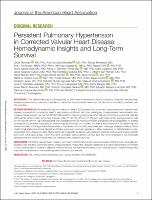| dc.contributor | Vall d'Hebron Barcelona Hospital Campus |
| dc.contributor.author | Bermejo, Javier |
| dc.contributor.author | González-Mansilla, Ana |
| dc.contributor.author | Mombiela, Teresa |
| dc.contributor.author | Fernández, Ana I. |
| dc.contributor.author | Martínez-Legazpi, Pablo |
| dc.contributor.author | Yotti, Raquel |
| dc.contributor.author | Evangelista Masip, Artur |
| dc.date.accessioned | 2021-06-11T12:32:02Z |
| dc.date.available | 2021-06-11T12:32:02Z |
| dc.date.issued | 2021-01-19 |
| dc.identifier.citation | Bermejo J, González‐Mansilla A, Mombiela T, Fernández AI, Martínez‐Legazpi P, Yotti R, et al. Persistent Pulmonary Hypertension in Corrected Valvular Heart Disease: Hemodynamic Insights and Long‐Term Survival. J Am Heart Assoc. 2021 Jan 19;10(2):e019949. |
| dc.identifier.issn | 2047-9980 |
| dc.identifier.uri | https://hdl.handle.net/11351/6056 |
| dc.description | Heart failure; Pulmonary hypertension; Valvular heart disease |
| dc.description.abstract | Background
The determinants and consequences of pulmonary hypertension after successfully corrected valvular heart disease remain poorly understood. We aim to clarify the hemodynamic bases and risk factors for mortality in patients with this condition.
Methods and Results
We analyzed long‐term follow‐up data of 222 patients with pulmonary hypertension and valvular heart disease successfully corrected at least 1 year before enrollment who had undergone comprehensive hemodynamic and imaging characterization as per the SIOVAC (Sildenafil for Improving Outcomes After Valvular Correction) clinical trial. Median (interquartile range) mean pulmonary pressure was 37 mm Hg (32–44 mm Hg) and pulmonary artery wedge pressure was 23 mm Hg (18–26 mm Hg). Most patients were classified either as having combined precapillary and postcapillary or isolated postcapillary pulmonary hypertension. After a median follow‐up of 4.5 years, 91 deaths accounted for 4.21 higher‐than‐expected mortality in the age‐matched population. Risk factors for mortality were male sex, older age, diabetes mellitus, World Health Organization functional class III and higher pulmonary vascular resistance—either measured by catheterization or approximated from ultrasound data. Higher pulmonary vascular resistance was related to diabetes mellitus and smaller residual aortic and mitral valve areas. In turn, the latter correlated with prosthetic nominal size. Six‐month changes in the composite clinical score and in the 6‐minute walk test distance were related to survival.
Conclusions
Persistent valvular heart disease–pulmonary hypertension is an ominous disease that is almost universally associated with elevated pulmonary artery wedge pressure. Pulmonary vascular resistance is a major determinant of mortality in this condition and is related to diabetes mellitus and the residual effective area of the corrected valve. These findings have important implications for individualizing valve correction procedures. |
| dc.language.iso | eng |
| dc.publisher | Wiley |
| dc.relation.ispartofseries | Journal of the American Heart Association;10(2) |
| dc.rights | Attribution-NonCommercial 4.0 International |
| dc.rights.uri | http://creativecommons.org/licenses/by-nc/4.0/ |
| dc.source | Scientia |
| dc.subject | Cor - Vàlvules - Malalties |
| dc.subject | Hipertensió pulmonar - Factors de risc |
| dc.subject.mesh | Heart Valve Diseases |
| dc.subject.mesh | Hypertension, Pulmonary |
| dc.subject.mesh | Risk Factors |
| dc.title | Persistent Pulmonary Hypertension in Corrected Valvular Heart Disease: Hemodynamic Insights and Long‐Term Survival |
| dc.type | info:eu-repo/semantics/article |
| dc.identifier.doi | 10.1161/JAHA.120.019949 |
| dc.subject.decs | enfermedades de las válvulas cardíacas |
| dc.subject.decs | hipertensión pulmonar |
| dc.subject.decs | factores de riesgo |
| dc.relation.publishversion | https://www.ahajournals.org/doi/10.1161/JAHA.120.019949 |
| dc.type.version | info:eu-repo/semantics/publishedVersion |
| dc.audience | Professionals |
| dc.contributor.organismes | Institut Català de la Salut |
| dc.contributor.authoraffiliation | [Bermejo J, González-Mansilla A, Mombiela T, Fernández AI, Martínez-Legazpi P] Hospital General Universitario Gregorio Marañón, Instituto de Investigación Sanitaria Gregorio Marañón, Facultad de Medicina, Universidad Complutense de Madrid, and CIBERCV Madrid Spain. [Yotti R] Instituto de Salud Carlos III Madrid Spain. [Evangelista A] Vall d'Hebron Hospital Universitari, Barcelona, Spain. CIBERCV Barcelona, Spain |
| dc.identifier.pmid | 33399006 |
| dc.identifier.wos | 000610049900028 |
| dc.relation.projectid | info:eu-repo/grantAgreement/ES/PE2017-2020/PI19%2F00649 |
| dc.rights.accessrights | info:eu-repo/semantics/openAccess |

